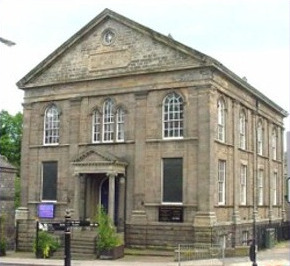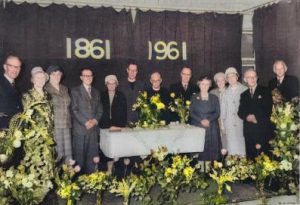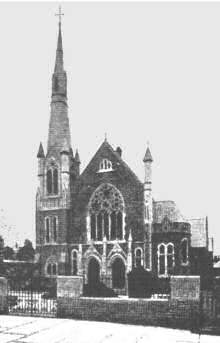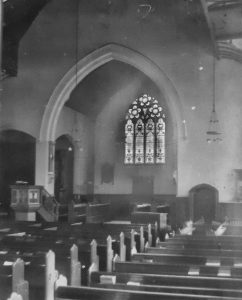This page gives a brief history of the various Methodist church buildings in Durham city centre.
Numbers in brackets in the text refer to locations on the map.
(1) First Methodist Meeting House, 1770

John Wesley’s first visit to Durham was made in 1742 and was followed by some twenty further visits until his death in 1799. During this time a local Methodist Society was formed but it was not until 1770 that the Methodist Meeting House in Rotten Row (now Court Lane) was opened as a place of worship. It stood at the corner of Court Lane and New Elvet until the 1940s when it was demolished to make way for the Fowler and Armstrong garage that, in turn, made way for the present Orchard House. Photographs of the dilapidated building exist. More interestingly there is a sketch plan of it (with dimensions) in the Woodieville Survey of cathedral owned property in the 1790s.
Membership was about 25-30 until about 1780 when Thomas Parker, a local barrister from Shincliffe, became heavily involved in the Meeting House. Membership doubled during his association so that when John Wesley preached there in 1788 he recorded in his diary “I preached at Durham at about eleven, to more than the house could contain. Even in this polite and elegant city we now want a large chapel”.
(2) Wesleyan Chapel, 1808

This large Wesleyan Chapel, described in 1856 as “a spacious and convenient building, containing upwards of 1,000 sittings”, was built in 1807-8 at a cost of £1,000 behind the present Royal County Hotel on land bought from the local Catholic Salvin family. (See location on 1857 map). A certificate to allow preaching there was issued by the cathedral authorities in October 1808, and the chapel was opened in early November 1808 by Dr Jabez Bunting. The request for the certificate was in the names of some dozen members of the Meeting House. The first of these was John Ward junior, a local property solicitor. He was a prominent member of both the Meeting House (as were his parents) and the Wesleyan Chapel, and later of the higher reaches of Methodism. He was particularly prominent in raising north-eastern resistance to the Sidmouth proposals to limit the movement of itinerant preachers at a time of national concern that the ideas behind the revolution in France might be spreading.
Photographs of the Wesleyan Chapel could only be taken, rather tangentially, down the narrow Chapel Passage. A more charming picture of the Chapel can be seen at the Heritage Centre in St Mary le Bow. There it features in an 1829 lithograph of Durham from across the river by Joseph (Nicholas) Bouet and is recognizable by the roundel in its gable end. It is also to be seen, from almost the same viewpoint, in a photograph of the 1926 regatta on the river in one of Michael Richardson’s compilations of old photographs of Durham.
(3) Primitive Methodist Chapel, 1826
“The Ranters”, as the Primitive Methodists were popularly known, came from Sunderland in 1824 to preach in Durham market place. A Primitive Methodist chapel was erected on Silver Street Lane (now Back Silver Street) in 1826. Described as “a small stone building”, it seated 220, and in the 1851 Religious Census is recorded by the minister, Peter Clarke, as having had an afternoon congregation of 175 and evening congregation of 187 on Sunday 30th March. (See location on 1857 map.)
(4-5) Methodist New Connexion meeting rooms
By the end of the 18th century, divisions in Wesleyan Methodism had begun to appear. In particular a demand for more lay influence in Methodism rather than the dominant ministerial authority led to the formation of the New Connexion in 1797. John Ward became a convert, and in 1830 took some 30 members of the Wesleyan Chapel with him into a new branch of the New Connexion. Initially they met in a school room belonging to John Ward in Chapel Passage, quite close to the Wesleyan Chapel (2). This quickly proved to be inadequate and while they searched for a suitable site, and funds, to build a chapel, for some years they met in the old school rooms in Old Elvet of St Cuthbert’s Catholic Church (4): the Catholic Chaplaincy now lies on the site of these school rooms. Finally they met in 15 Old Elvet (5) from about 1845 to 1854 until their new chapel was opened on North Road.
(6) Methodist New Connexion’s Bethel Chapel, 1854

The foundation stone of Bethel Chapel was laid on 4th May, 1853: a report of the ceremony and tea (with a summary of the speeches) appears in the Durham Advertiser, 6 May, 1853 – an abridged version of the report is in The Methodist New Connexion Magazine of June 1853. From Mr R. Thwaites’ speech it is clear that North Road had not been the first location of choice for many, but it was acknowledged that the Elvet area already had several dissenting chapels while the Framwellgate side of the city had none, and they hoped that it would prove a fruitful mission field.
Bethel Chapel was designed in a classical style by the seventeen-year-old E.R. Robson, with a large gallery above the worship area and a schoolroom in the basement. It is now a Grade II listed building. View its entry on the Historic England website.
Keen eyes may be able to spot the recently-opened Bethel Chapel in the background of photographs showing the construction of the railway viaduct in 1854-57.
In 1907 when the Methodist New Connexion joined with the Bible Christians and the United Methodist Free Churches, Bethel Chapel became part of the United Methodist Church.
(7) Jubilee Chapel, 1861

on North Road

photographed from the gallery
The Primitive Methodist congregation having outgrown the chapel on Back Silver Street, the foundation stone for a new chapel near the bottom of North Road was laid by Sir William Atherton, who was Solicitor General and an MP for Durham, on October 22nd 1860 following a procession from the Town hall to the new location. There were 2,000 people present at the ceremony and the following tea meeting.
The new Gothic style Jubilee Chapel was designed by Gibson Kyle. It cost around £2,000, held 600 people, had galleries on 3 sides and boasted a starlight with 51 gas jets suspended from the ceiling.
The opening in May 1861 of Jubilee Chapel is recorded in the Primitive Methodist Magazine for October 1861. The opening sermons were preached on 19th and 26th May 1861, by Revs. T. Greenbury, W. Clemitson, H. Phillips, W. Antliff, W. Lister, W. Shearman (Wesleyan), and S. Goodhall (Independent).

Jubilee Methodist Church was demolished shortly after celebrating its centenary in 1961, when the congregation moved up the road to join with Bethel Chapel to form North Road Methodist Church. An Iceland supermarket now stands on the site.
As it was set back from the road, Jubilee is not often seen on old photographs of North Road, but it is visible in the background of a photograph of St Godric’s Church in Michael Richardson’s “Lost Durham” (2019).
More information on the Primitive Methodist chapels can be found on the “My Primitive Methodists” website.
(8) Elvet Methodist Church, 1903
At the Wesleyan Chapel it took some years to recover from the loss of the breakaway members, but under the Rev Thomas Collins membership again increased. It became clear during the later part of the 19th century that the site was less than ideal, being now hidden by the Royal County Hotel and only accessible by Chapel Passage. Discussions and discreet enquiries went on for many years before the preferred site on Old Elvet became available. In the meantime the hidden Wesleyan Chapel was severely criticised by a national report in the late 1890s on the “presence” of Methodist chapels in cities.

The Old Elvet site finally became available in 1902 and the new church completed in 1903, whereupon the Wesleyan Chapel was sold to become the Citadel of the Salvation Army; its latter years saw use as a bakery. The chapel was largely demolished to make way for the expansion of the Royal County Hotel. Some stone remains of it can still be seen in the car park of the hotel, as part of the wall which separates the car park from the houses next to Territorial Lane. (The middle house, wrongly numbered 53, is really number 54 where John Ward lived until his death in 1856).

original interior
The Wesleyan Methodist Church on Old Elvet (architect: W.J. Morley & Son) was opened in November 1903 with a week of celebrations. Built with an initial capacity of about 600 it is the largest church building in the local Durham and Deerness Valley Methodist Circuit.
With the union of the Primitive, Wesleyan and United Methodists in 1932, the church name was changed to Elvet Methodist Church, though it was sometimes referred to as Old Elvet Methodist Church.
Externally Elvet Methodist Church has changed little, though the church interior and rear premises saw some changes in 1994-5 to make both church and premises suitable for more activities and use by the wider community.
Uniting of churches
North Road Methodist Church, 1961

In 1961 the congregations of the two Methodist churches on North Road, Bethel and Jubilee, combined into one. They had hoped to build a modern church on a new site and sell both existing premises, but the plans for a new building did not come to fruition. As we have seen, Jubilee Chapel was sold, and the two congregations came together at Bethel to form North Road Methodist Church.
The church interior saw changes in 1974 with the removal of pews and the elevated pulpit. Further improvements were made in 2010 including the installation of a lift and modern kitchen.
Durham City Methodists, 2021
In 2021 the congregations of Elvet and North Road Methodist Churches came together to form Durham City Methodists – one church operating on two sites.